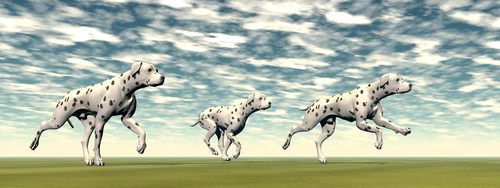
In dogs, “Elbowing out” is a term that is exactly what it sounds like. One, or both of the dog’s elbows twist or turn out from its chest as it gaits, the time it’s most easily spotted. Besides being distracting (and not in a good way), elbowing out is inefficient. It wastes energy because it’s a tiring way for a dog to move, and this leads to a decrease in endurance. It’s a serious fault in breeds designed for speed or trotting, and is one reason why some dog show judges will ask for a “loose lead.” The fault is easily hidden by an experienced handler when the dog is stacked, but being “out at the elbows” is far more difficult to hide when the dog is moving, particularly in a short-haired breed.
There are several reasons why a dog may be elbowing out. It could be as innocent as a minor muscle pull from horsing around too much, a dog having put on weight too fast, or be indicative of poor nutrition or muscle condition. It can also be caused by muscles under the shoulder blades being too heavy, a condition that fanciers call “loaded shoulders.” Other causes: The shoulder blade is too far forward on the dog’s chest, the elbow joints are in a wider vertical plane than the point of shoulders, the dog’s brisket is markedly higher above the elbows, or the dog is pigeon toed.
At its worst, elbow bowing out can be a sign of a serious condition like elbow dysplasia, or a luxating (or dislocated) elbow. A vet needs to make this determination.
Elbows with regards to movement are important enough to mention in at least one breed standard, and it belongs to the Dalmatian. It reads, “Gait: In keeping with the Dalmatian’s historical use as a coach dog, gait and endurance are of great importance. Movement is steady and effortless. Balanced angulation fore and aft combined with powerful muscles and good condition produce smooth, efficient action. There is a powerful drive from the rear coordinated with extended reach in the front. The topline remains level. Elbows, hocks and feet turn neither in nor out.”
There is a marvelous article about elbows by Fred Lanting that’s worth the time it takes to read.
We don’t have pictures to share of a dog “elbowing out,” but we invite educationally-minded readers to share their own pictures of “elbowing out,” if they have any. For now, we use an image of running Dalmatians
